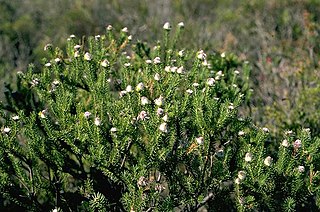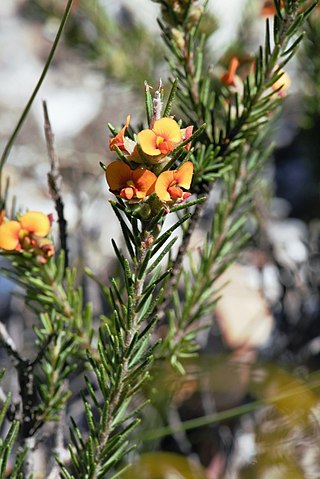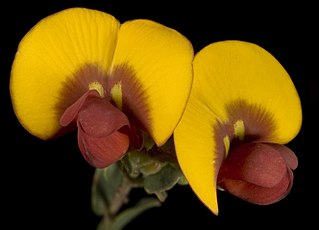
Grevillea paniculata, commonly known as kerosene bush, is a species of flowering plant in the family Proteaceae and is endemic to the south-west of Western Australia. It is a dense shrub with divided leaves, the lobes linear, and more or less spherical clusters of white to cream-coloured flowers.

Grevillea brachystachya, commonly known as short-spiked grevillea, is a species of flowering plant in the family Proteaceae and is endemic to the south-west of Western Australia. It is a bushy shrub with linear leaves and more or less spherical clusters of cream-coloured to greenish flowers.

Grevillea cirsiifolia, commonly known as varied-leaf grevillea, is a species of flowering plant in the family Proteaceae and is endemic to the south-west of Western Australia. It is a prostrate shrub, usually with divided leaves with eight to thirty lobes, and creamy white and bright yellow flowers with a white to pale yellow style.
Grevillea pinifolia, commonly known as the pine-leaved grevillea, is a species of flowering plant in the family Proteaceae and is endemic to a restricted area in the south-west of Western Australia. It is a low, mounded shrub with linear, more or less cylindrical leaves and red to orange-red flowers.

Petrophile drummondii is a species of flowering plant in the family Proteaceae and is endemic to southwestern Western Australia. It is a shrub with rigid, pinnate leaves with needle-shaped, sharply-pointed pinnae, and spherical heads of hairy, fragrant, yellow flowers.

Petrophile scabriuscula is a species of flowering plant in the family Proteaceae and is endemic to southwestern Western Australia. It is a dense, prickly shrub with sharply-pointed, needle-shaped leaves more or less pressed against the branchlets, and oval heads of hairy, yellow to creamy-yellow flowers.

Marianthus drummondianus is a species of flowering plant in the family Pittosporaceae and is endemic to the southwest of Western Australia. It is a shrub, herb, or slender twiner with elliptic leaves and white, blue or purple flowers arranged in small clusters.

Dillwynia brunioides, commonly known as sandstone parrot-pea, is a species of flowering plant in the family Fabaceae and is endemic to New South Wales. It is an erect shrub with silky-hairy stems, linear, grooved leaves and yellow flowers with red markings.
Dillwynia dillwynioides is a species of flowering plant in the family Fabaceae and is endemic to the south-west of Western Australia. It is a low-lying or erect, spindly shrub with cylindrical, grooved leaves and yellow, red or orange flowers with yellow, red or orange markings.
Pultenaea aspalathoides is a species of flowering plant in the family Fabaceae and is endemic to the south of Western Australia. It is an erect, spindly shrub with hairy, needle-shaped leaves and yellow flowers.

Pultenaea empetrifolia is a species of flowering plant in the family Fabaceae and is endemic to the south-west of Western Australia. It is a spindly, prostrate or spreading shrub with down-curved, cylindrical, grooved leaves and yellow to orange and red flowers.

Gompholobium burtonioides is a species of flowering plant in the family Fabaceae and is endemic to the south-west of Western Australia. It an ascending shrub that typically grows to a height of 15–45 cm (5.9–17.7 in) and flowers from September to December producing yellow, pea-like flowers. This species was first formally described in 1844 by Carl Meissner in Lehmann's Plantae Preissianae. The specific epithet (burtonioides) means "Burtonia-like".

Pultenaea ochreata is a species of flowering plant in the family Fabaceae and is endemic to the south-west of Western Australia. It is an erect shrub with egg-shaped leaves with the narrower end towards the base and yellow-orange flowers with red or brown marks.
Pultenaea pinifolia is a species of flowering plant in the family Fabaceae and is endemic to the south-west of Western Australia. It is an erect, slender shrub with pine-like leaves and yellow-orange flowers with orange marks.

Gompholobium ovatum is a species of flowering plant in the family Fabaceae and is endemic to the south-west of Western Australia. It is an erect or prostrate shrub with egg-shaped leaves and yellow and red to purple, pea-like flowers.

Bossiaea pulchella is a species of flowering plant in the family Fabaceae and is endemic to the south-west of Western Australia. It is a slender, erect shrub with egg-shaped leaves, and orange-yellow, purplish brown and dark red flowers.

Gompholobium preissii is a species of flowering plant in the family Fabaceae and is endemic to the south-west of Western Australia. It is an erect shrub with pinnate leaves with five to fifteen leaflets, and yellow, red and orange, pea-like flowers.

Gompholobium shuttleworthii is a species of flowering plant in the pea family Fabaceae and is endemic to the south-west of Western Australia. It is an erect shrub with pinnate leaves with five to nine leaflets, and pink or purple flowers with some darker markings.
Bossiaea spinescens is a species of flowering plant in the family Fabaceae and is endemic to the south-west of Western Australia. It is a slender, spreading or compact, spiny shrub with oblong to oval leaves and yellow and reddish-brown, pea-like flowers.
Gompholobium viscidulum is a species of flowering plant in the pea family Fabaceae and is endemic to the south-west of Western Australia. It is an erect shrub with pinnate leaves with five to seven leaflets, and yellow flowers.














